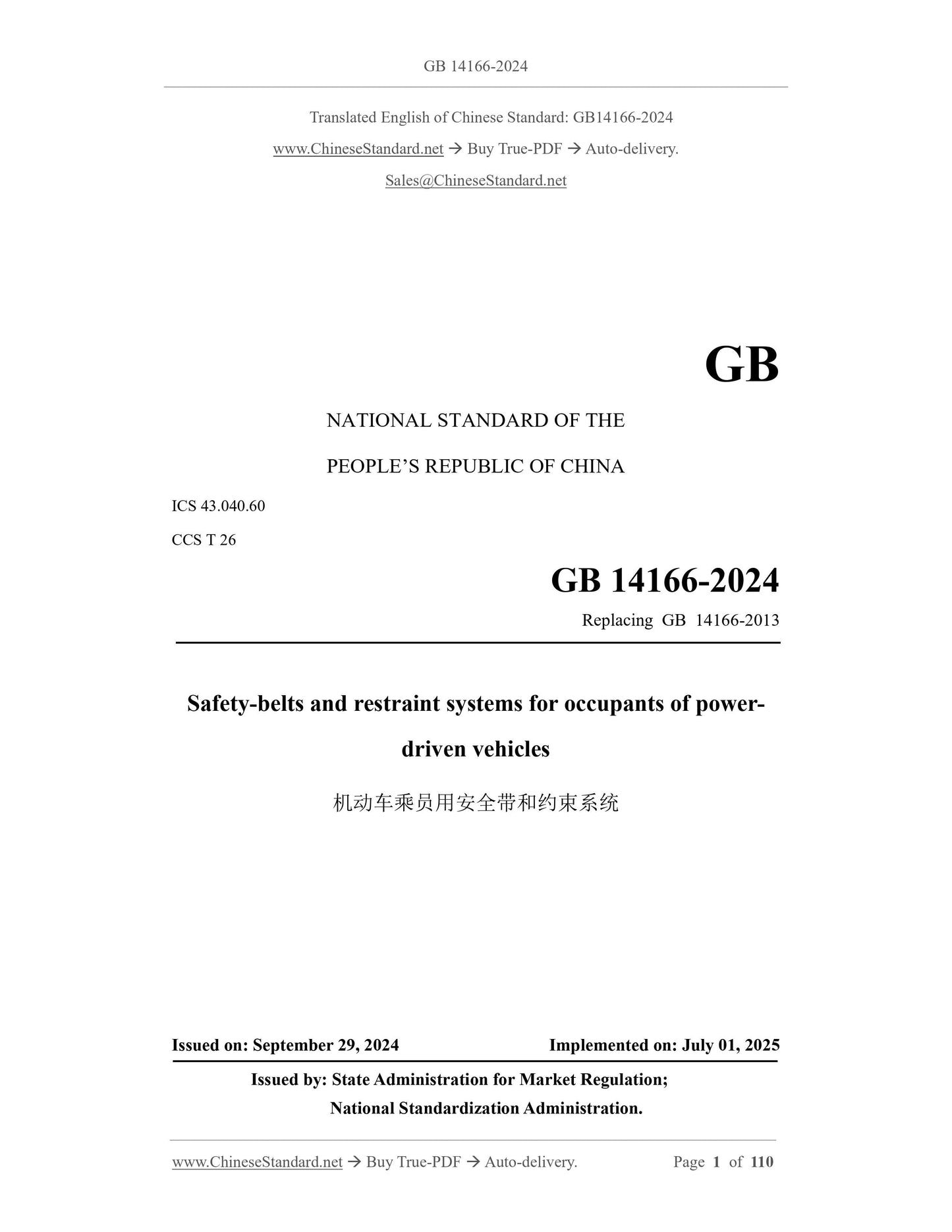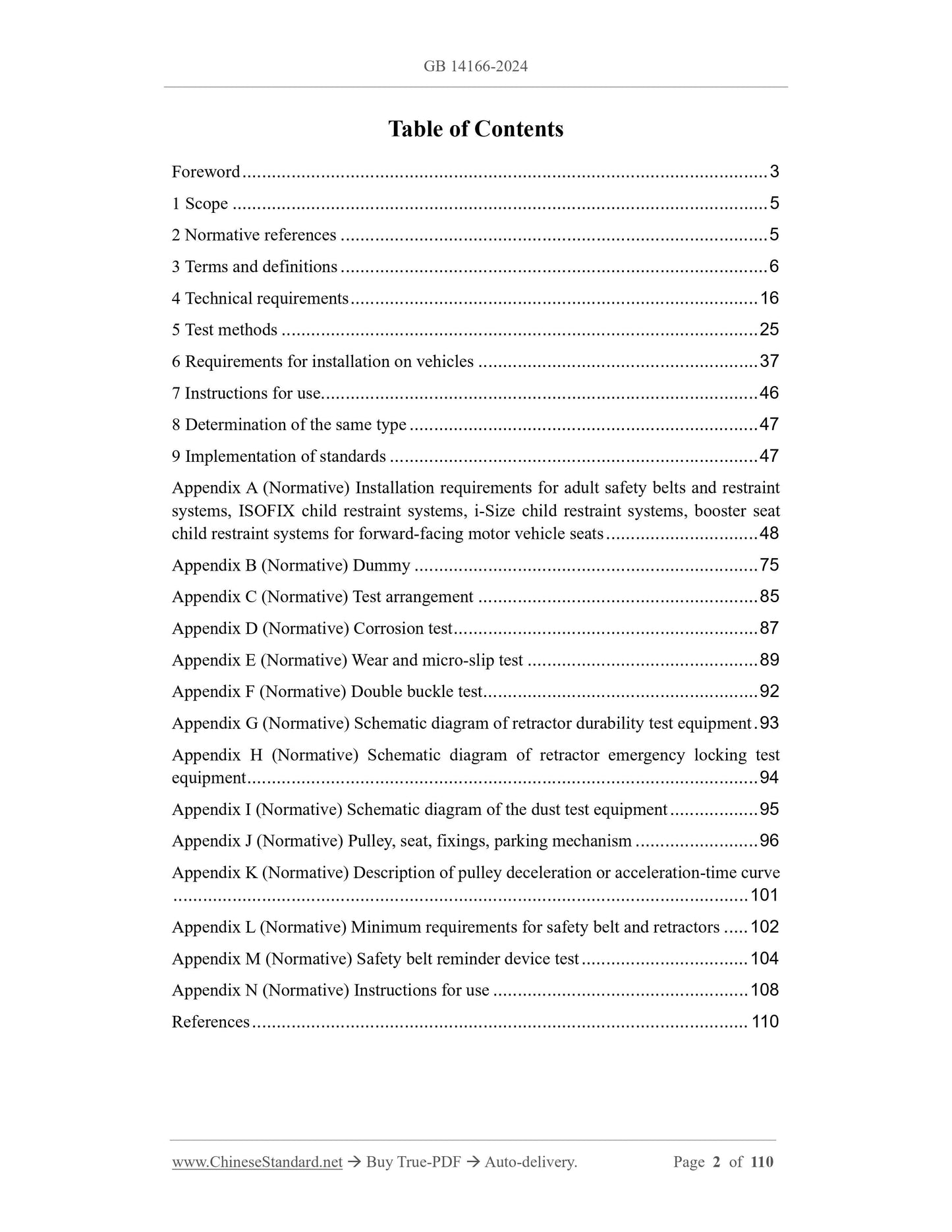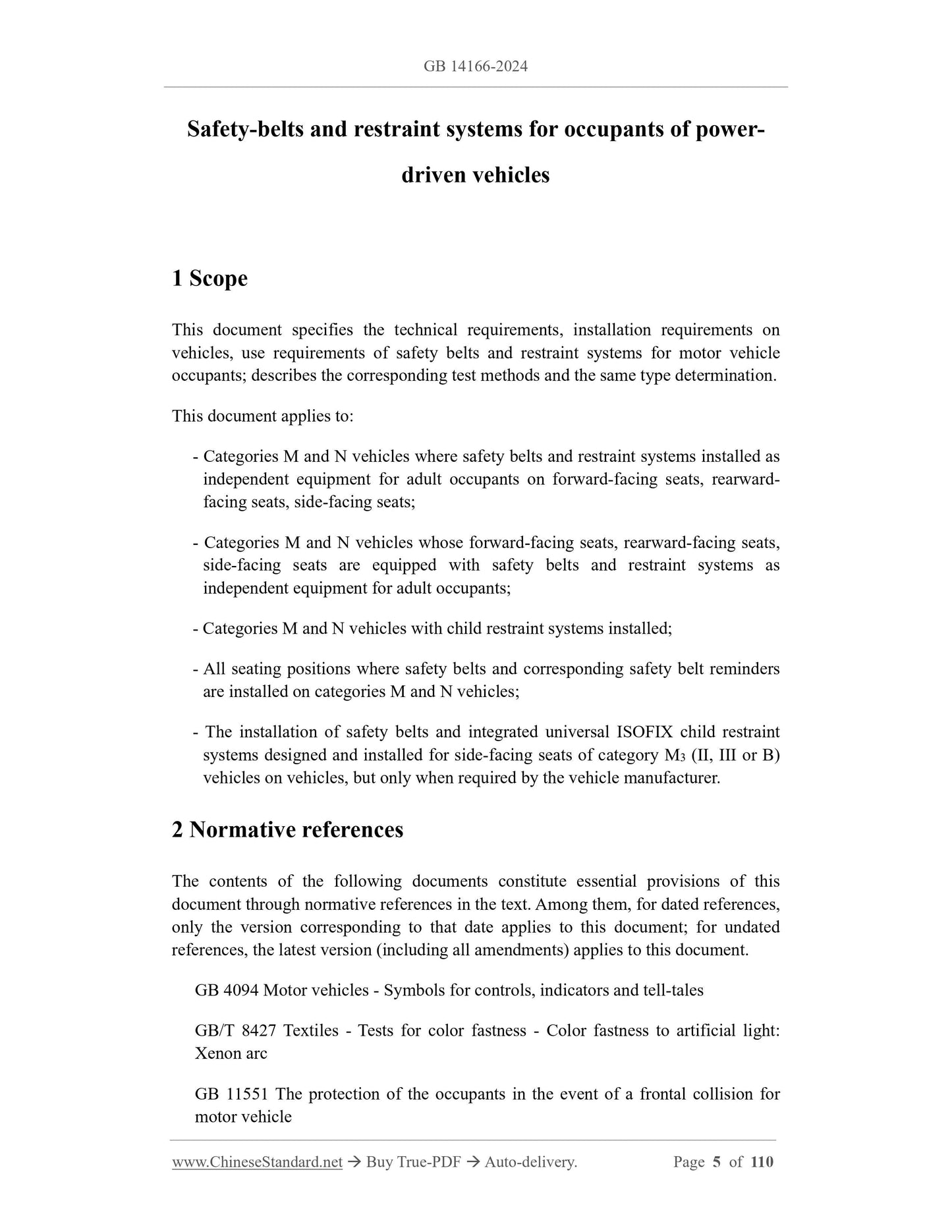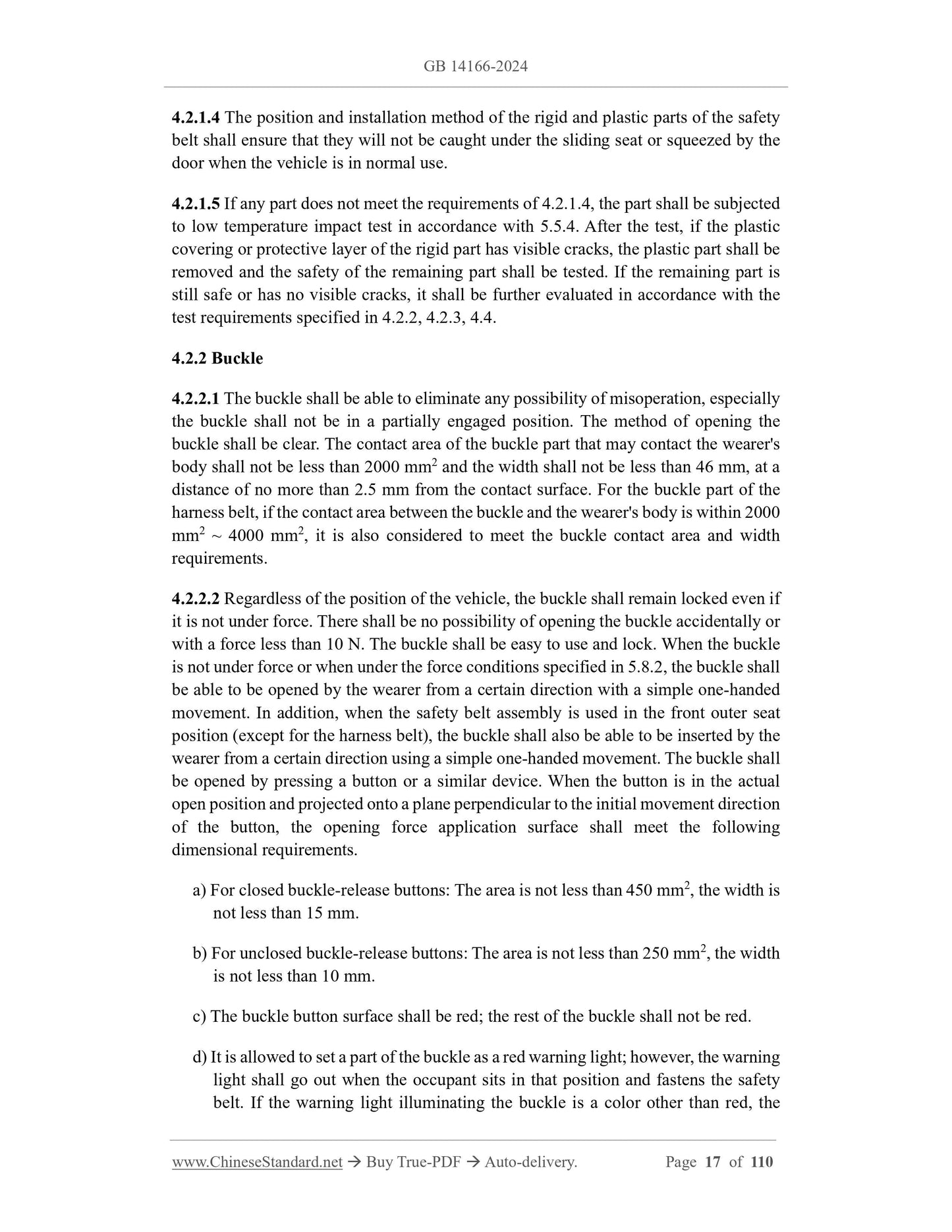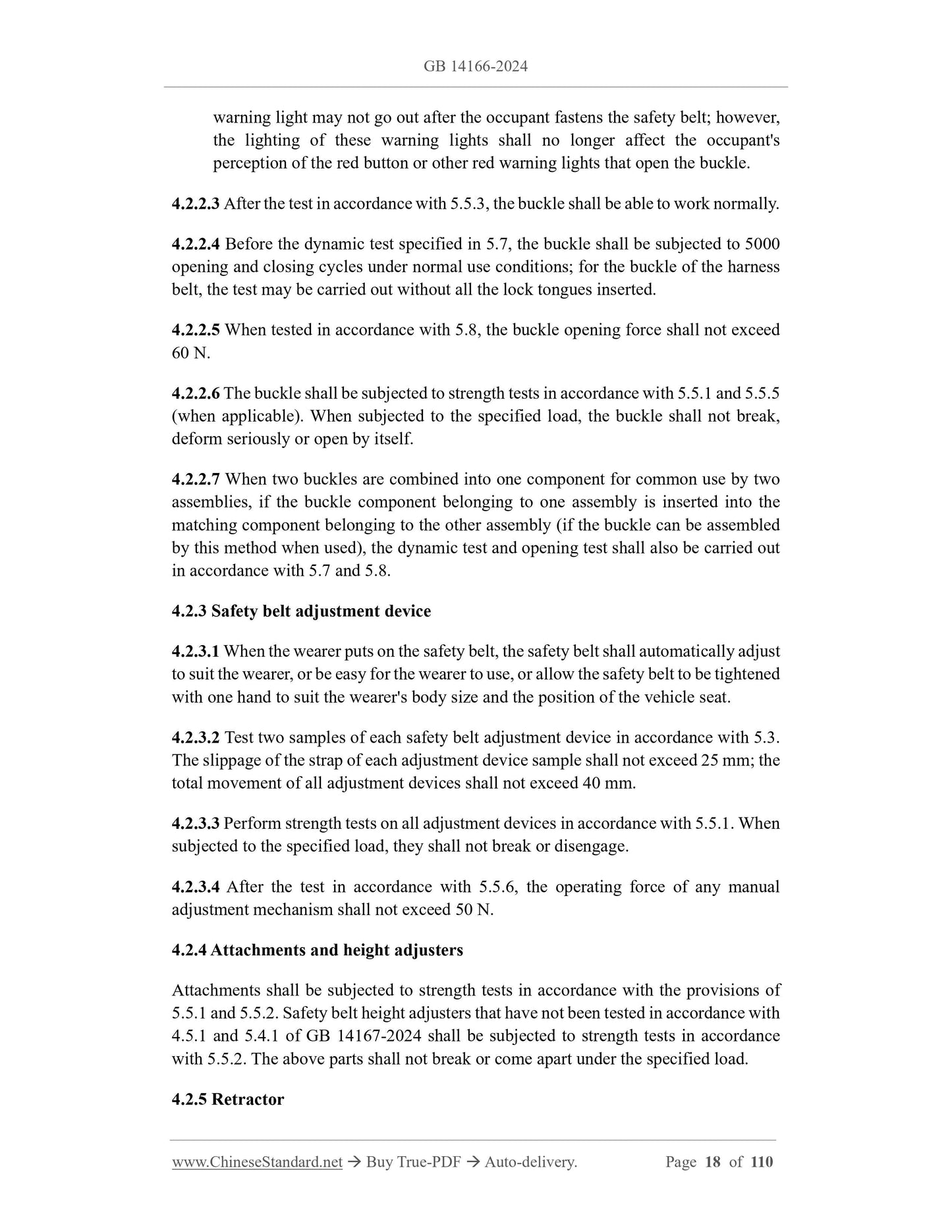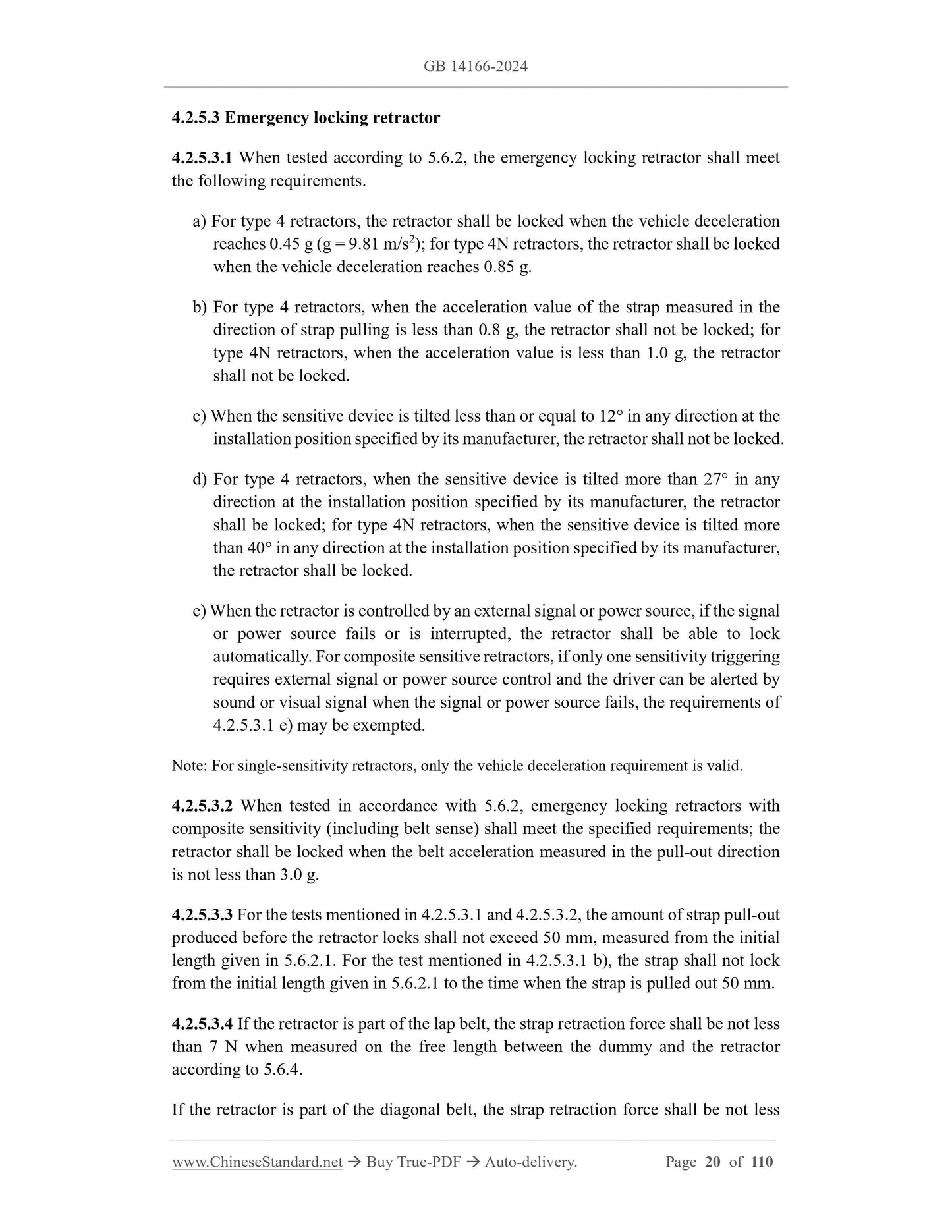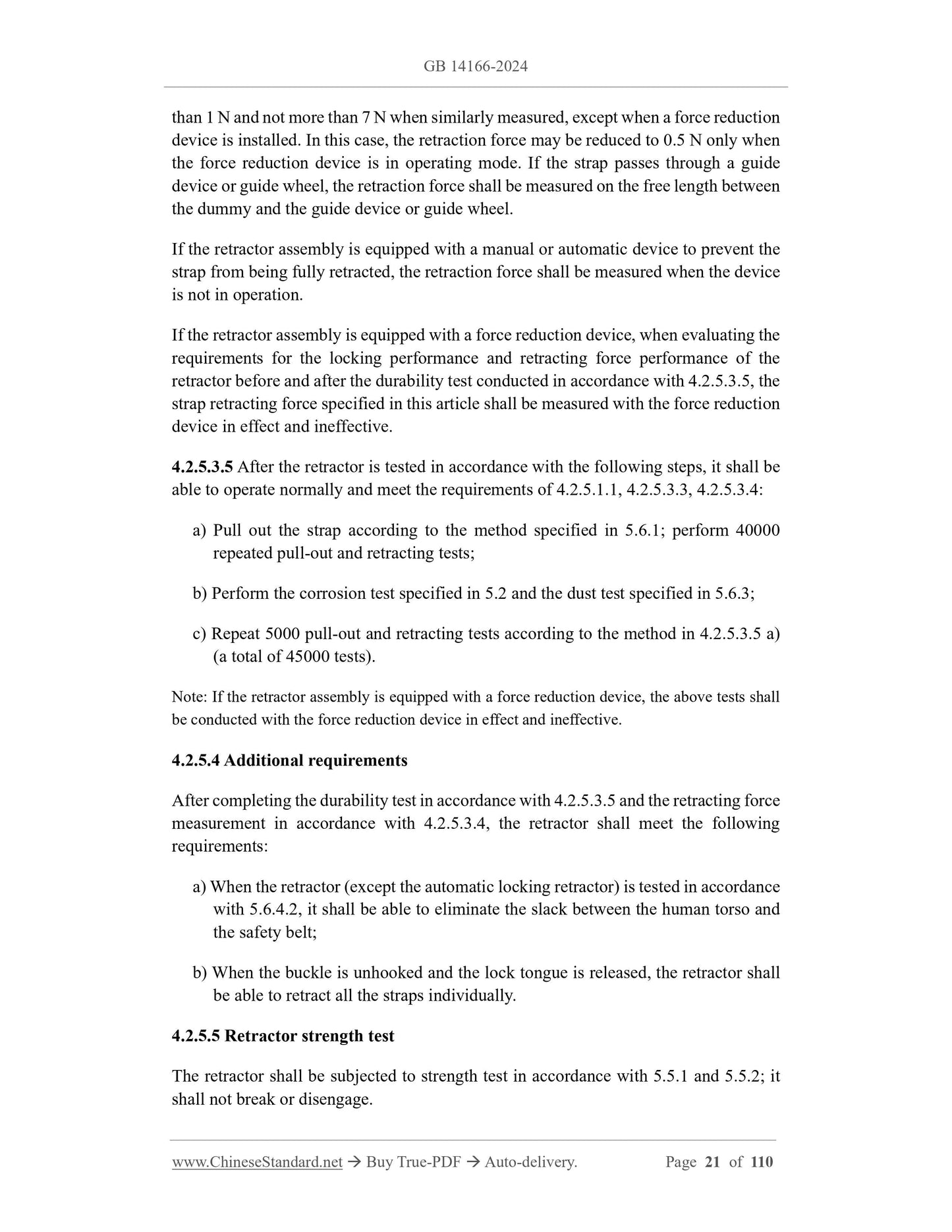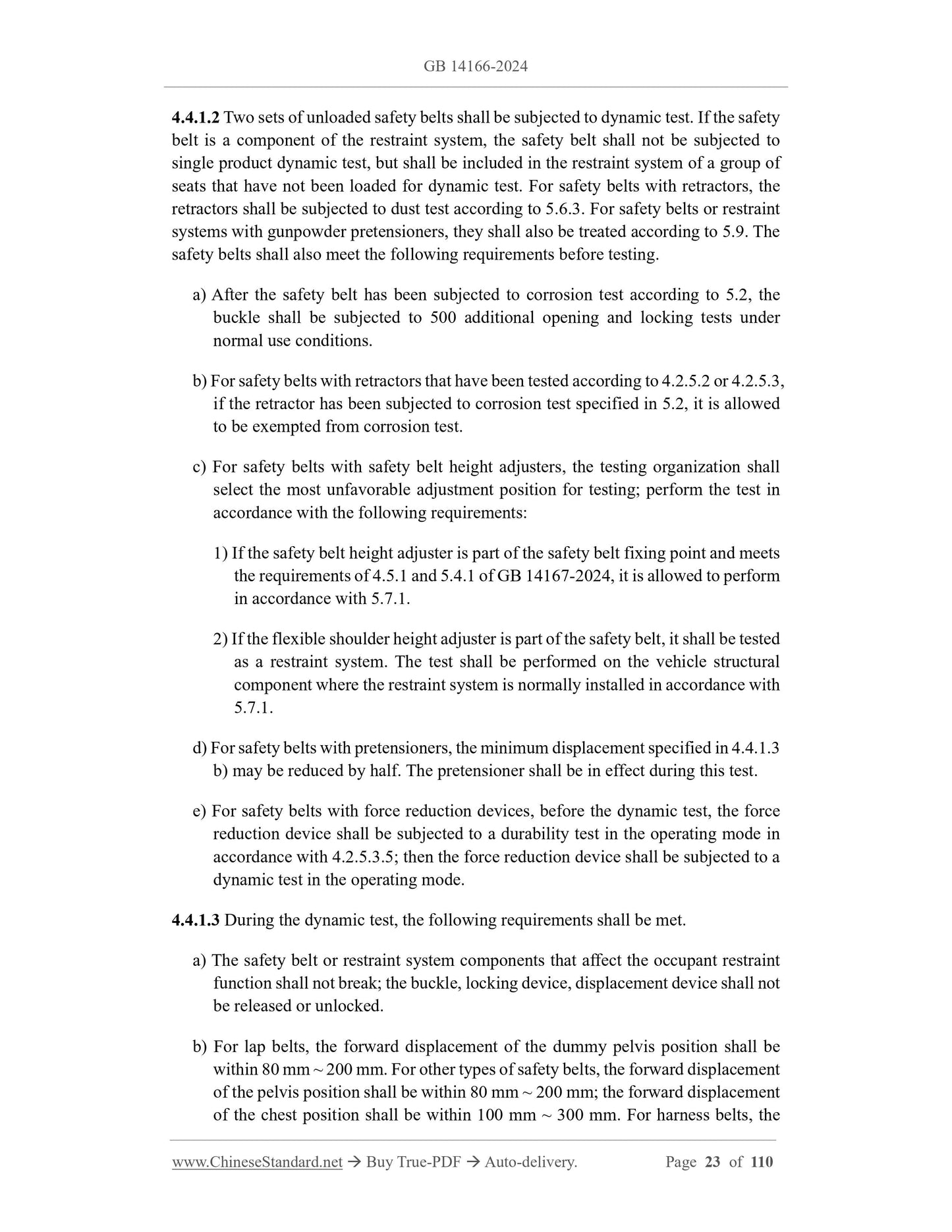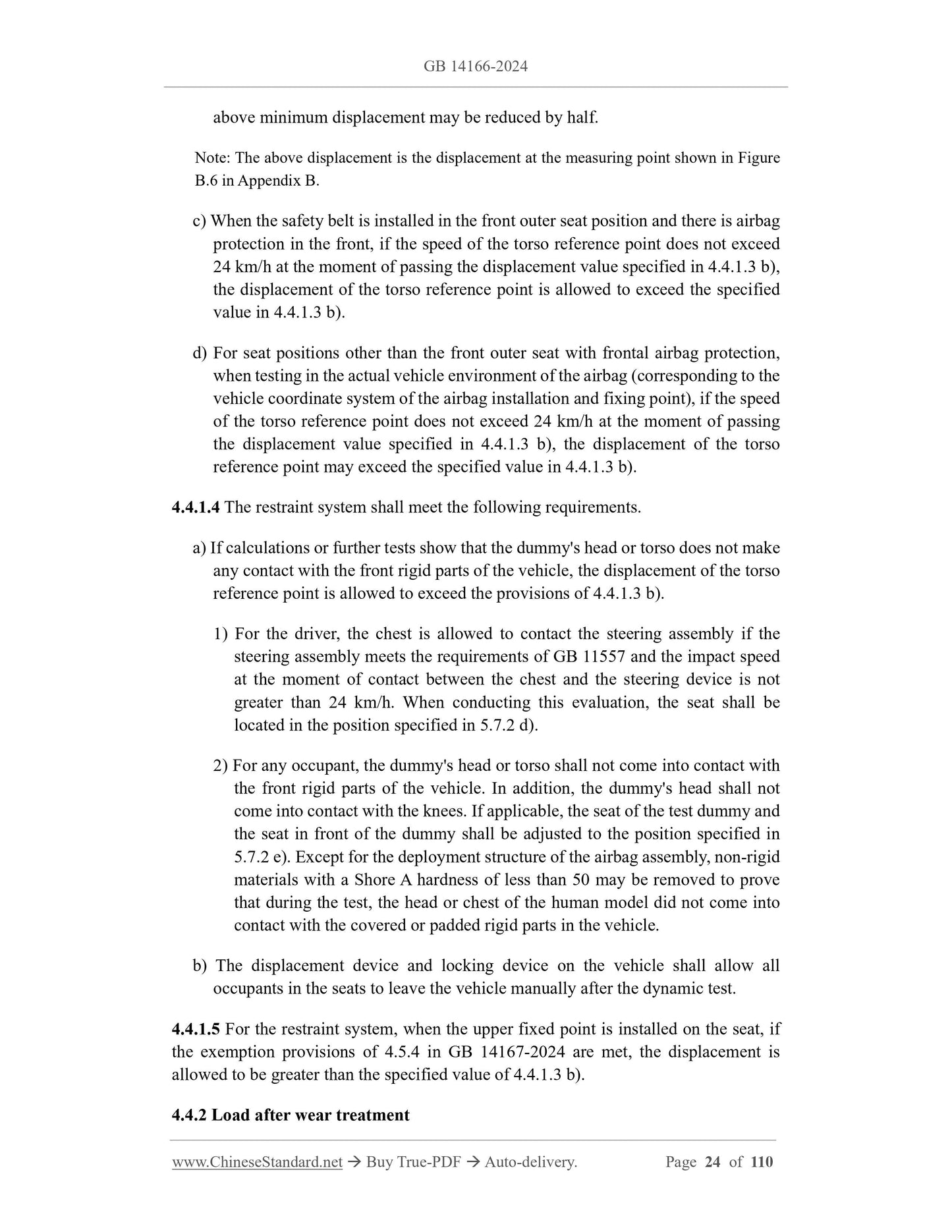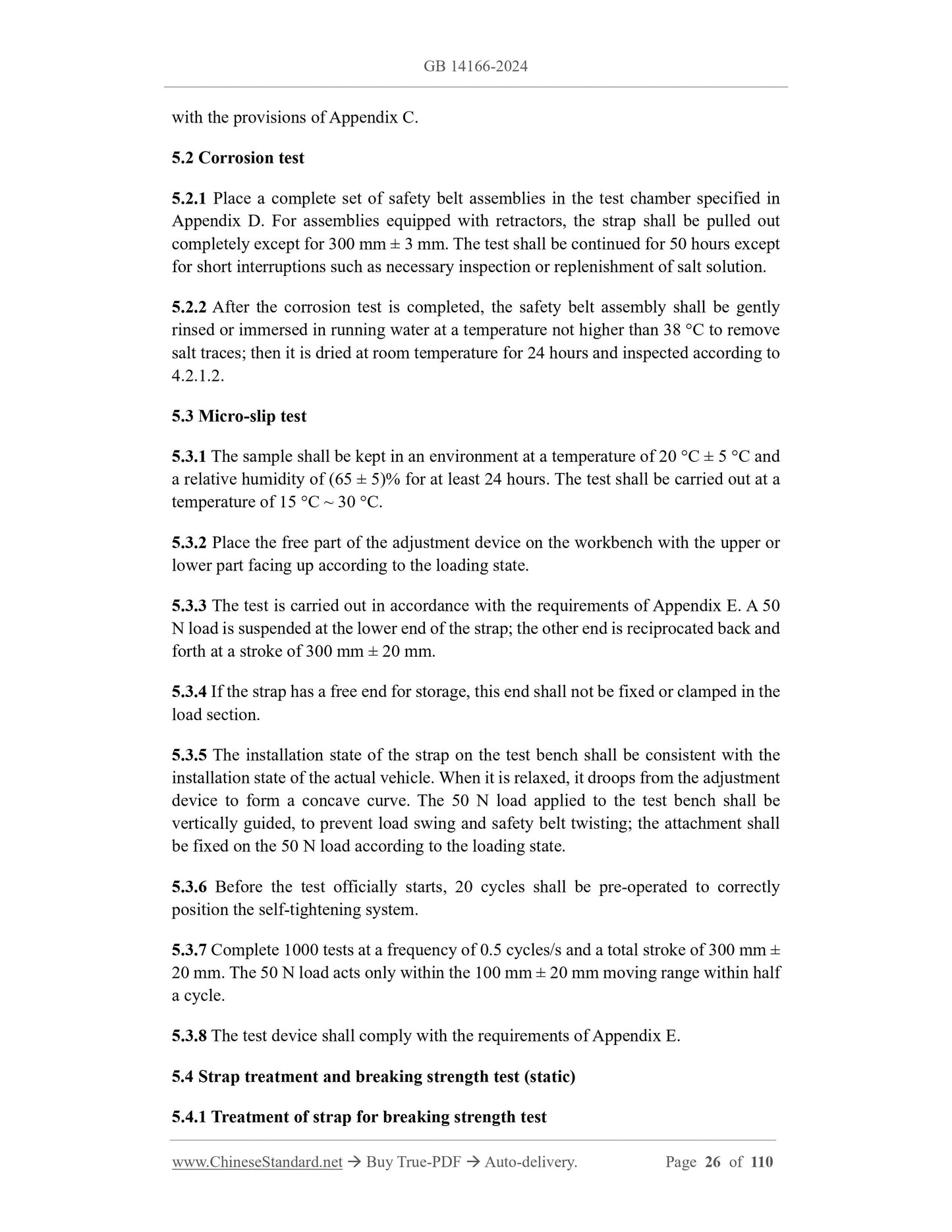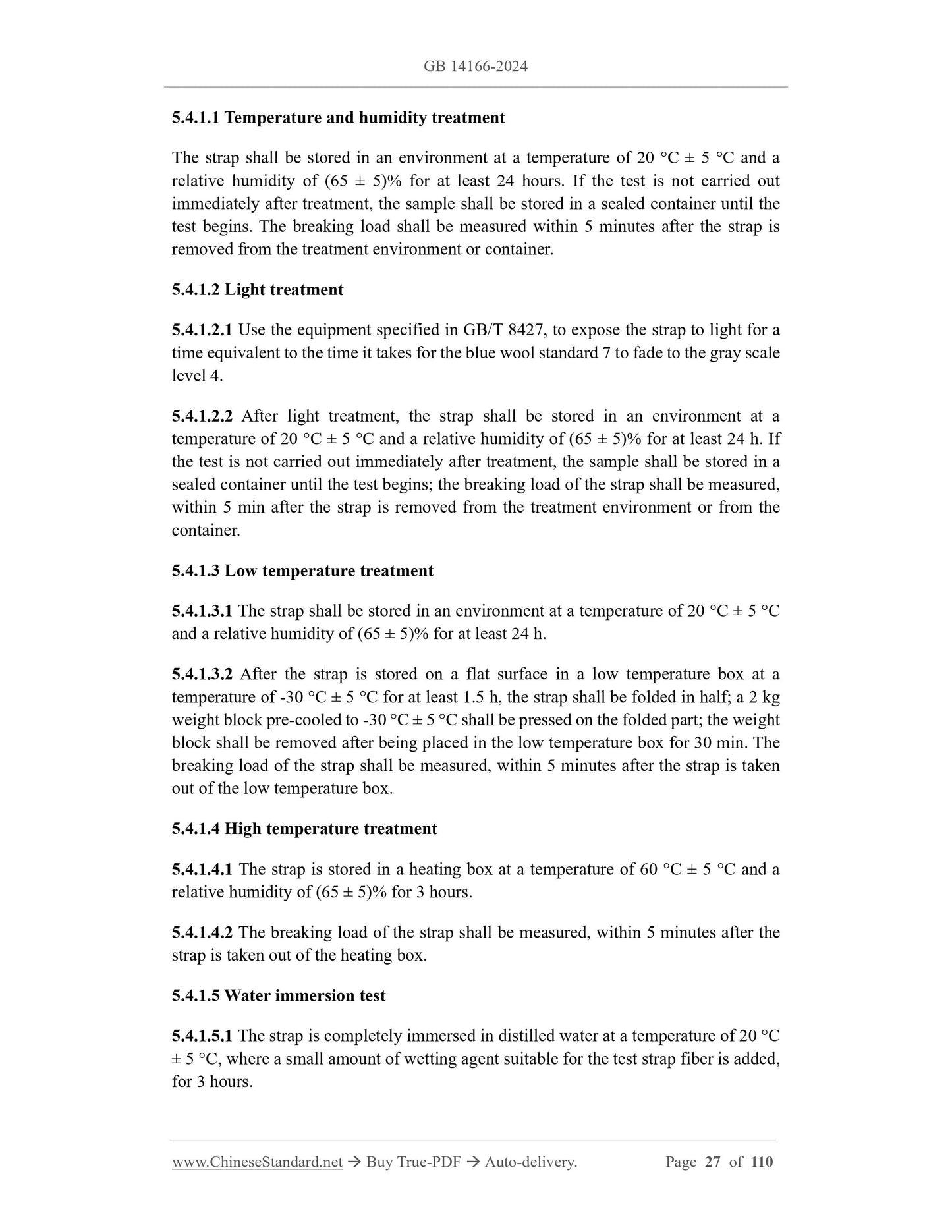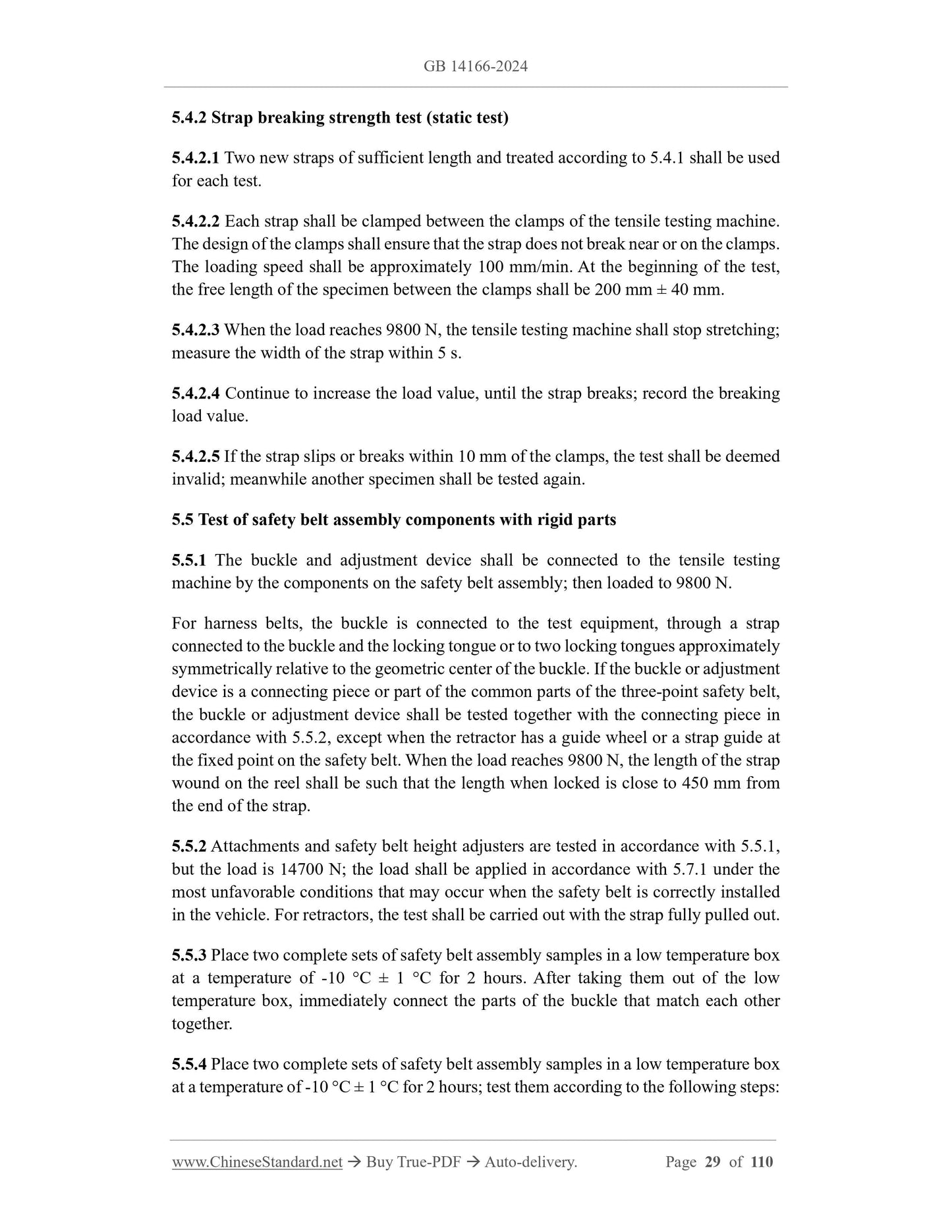1
/
de
12
PayPal, credit cards. Download editable-PDF and invoice in 1 second!
GB 14166-2024 English PDF (GB14166-2024)
GB 14166-2024 English PDF (GB14166-2024)
Prix habituel
$1,265.00 USD
Prix habituel
Prix promotionnel
$1,265.00 USD
Prix unitaire
/
par
Frais d'expédition calculés à l'étape de paiement.
Impossible de charger la disponibilité du service de retrait
Delivery: 3 seconds. Download true-PDF + Invoice.
Get QUOTATION in 1-minute: Click GB 14166-2024
Historical versions: GB 14166-2024
Preview True-PDF (Reload/Scroll if blank)
GB 14166-2024: Safety-belts and restraint systems for occupants of power-driven vehicles
GB 14166-2024
GB
NATIONAL STANDARD OF THE
PEOPLE’S REPUBLIC OF CHINA
ICS 43.040.60
CCS T 26
Replacing GB 14166-2013
Safety-belts and restraint systems for occupants of power-
driven vehicles
ISSUED ON: SEPTEMBER 29, 2024
IMPLEMENTED ON: JULY 01, 2025
Issued by: State Administration for Market Regulation;
National Standardization Administration.
Table of Contents
Foreword ... 3
1 Scope ... 5
2 Normative references ... 5
3 Terms and definitions ... 6
4 Technical requirements ... 16
5 Test methods ... 25
6 Requirements for installation on vehicles ... 37
7 Instructions for use... 46
8 Determination of the same type ... 47
9 Implementation of standards ... 47
Appendix A (Normative) Installation requirements for adult safety belts and restraint
systems, ISOFIX child restraint systems, i-Size child restraint systems, booster seat
child restraint systems for forward-facing motor vehicle seats ... 48
Appendix B (Normative) Dummy ... 75
Appendix C (Normative) Test arrangement ... 85
Appendix D (Normative) Corrosion test ... 87
Appendix E (Normative) Wear and micro-slip test ... 89
Appendix F (Normative) Double buckle test ... 92
Appendix G (Normative) Schematic diagram of retractor durability test equipment . 93
Appendix H (Normative) Schematic diagram of retractor emergency locking test
equipment ... 94
Appendix I (Normative) Schematic diagram of the dust test equipment ... 95
Appendix J (Normative) Pulley, seat, fixings, parking mechanism ... 96
Appendix K (Normative) Description of pulley deceleration or acceleration-time curve
... 101
Appendix L (Normative) Minimum requirements for safety belt and retractors ... 102
Appendix M (Normative) Safety belt reminder device test ... 104
Appendix N (Normative) Instructions for use ... 108
References ... 110
Safety-belts and restraint systems for occupants of power-
driven vehicles
1 Scope
This document specifies the technical requirements, installation requirements on
vehicles, use requirements of safety belts and restraint systems for motor vehicle
occupants; describes the corresponding test methods and the same type determination.
This document applies to:
- Categories M and N vehicles where safety belts and restraint systems installed as
independent equipment for adult occupants on forward-facing seats, rearward-
facing seats, side-facing seats;
- Categories M and N vehicles whose forward-facing seats, rearward-facing seats,
side-facing seats are equipped with safety belts and restraint systems as
independent equipment for adult occupants;
- Categories M and N vehicles with child restraint systems installed;
- All seating positions where safety belts and corresponding safety belt reminders
are installed on categories M and N vehicles;
- The installation of safety belts and integrated universal ISOFIX child restraint
systems designed and installed for side-facing seats of category M3 (II, III or B)
vehicles on vehicles, but only when required by the vehicle manufacturer.
2 Normative references
The contents of the following documents constitute essential provisions of this
document through normative references in the text. Among them, for dated references,
only the version corresponding to that date applies to this document; for undated
references, the latest version (including all amendments) applies to this document.
GB 4094 Motor vehicles - Symbols for controls, indicators and tell-tales
GB/T 8427 Textiles - Tests for color fastness - Color fastness to artificial light:
Xenon arc
GB 11551 The protection of the occupants in the event of a frontal collision for
motor vehicle
4.2.1.4 The position and installation method of the rigid and plastic parts of the safety
belt shall ensure that they will not be caught under the sliding seat or squeezed by the
door when the vehicle is in normal use.
4.2.1.5 If any part does not meet the requirements of 4.2.1.4, the part shall be subjected
to low temperature impact test in accordance with 5.5.4. After the test, if the plastic
covering or protective layer of the rigid part has visible cracks, the plastic part shall be
removed and the safety of the remaining part shall be tested. If the remaining part is
still safe or has no visible cracks, it shall be further evaluated in accordance with the
test requirements specified in 4.2.2, 4.2.3, 4.4.
4.2.2 Buckle
4.2.2.1 The buckle shall be able to eliminate any possibility of misoperation, especially
the buckle shall not be in a partially engaged position. The method of opening the
buckle shall be clear. The contact area of the buckle part that may contact the wearer's
body shall not be less than 2000 mm2 and the width shall not be less than 46 mm, at a
distance of no more than 2.5 mm from the contact surface. For the buckle part of the
harness belt, if the contact area between the buckle and the wearer's body is within 2000
mm2 ~ 4000 mm2, it is also considered to meet the buckle contact area and width
requirements.
4.2.2.2 Regardless of the position of the vehicle, the buckle shall remain locked even if
it is not under force. There shall be no possibility of opening the buckle accidentally or
with a force less than 10 N. The buckle shall be easy to use and lock. When the buckle
is not under force or when under the force conditions specified in 5.8.2, the buckle shall
be able to be opened by the wearer from a certain direction with a simple one-handed
movement. In addition, when the safety belt assembly is used in the front outer seat
position (except for the harness belt), the buckle shall also be able to be inserted by the
wearer from a certain direction using a simple one-handed movement. The buckle shall
be opened by pressing a button or a similar device. When the button is in the actual
open position and projected onto a plane perpendicular to the initial movement direction
of the button, the opening force application surface shall meet the following
dimensional requirements.
a) For closed buckle-release buttons: The area is not less than 450 mm2, the width is
not less than 15 mm.
b) For unclosed buckle-release buttons: The area is not less than 250 mm2, the width
is not less than 10 mm.
c) The buckle button surface shall be red; the rest of the buckle shall not be red.
d) It is allowed to set a part of the buckle as a red warning light; however, the warning
light shall go out when the occupant sits in that position and fastens the safety
belt. If the warning light illuminating the buckle is a color other than red, the
warning light may not go out after the occupant fastens the safety belt; however,
the lighting of these warning lights shall no longer affect the occupant's
perception of the red button or other red warning lights that open the buckle.
4.2.2.3 After the test in accordance with 5.5.3, the buckle shall be able to work normally.
4.2.2.4 Before the dynamic test specified in 5.7, the buckle shall be subjected to 5000
opening and closing cycles under normal use conditions; for the buckle of the harness
belt, the test may be carried out without all the lock tongues inserted.
4.2.2.5 When tested in accordance with 5.8, the buckle opening force shall not exceed
60 N.
4.2.2.6 The buckle shall be subjected to strength tests in accordance with 5.5.1 and 5.5.5
(when applicable). When subjected to the specified load, the buckle shall not break,
deform seriously or open by itself.
4.2.2.7 When two buckles are combined into one...
Get QUOTATION in 1-minute: Click GB 14166-2024
Historical versions: GB 14166-2024
Preview True-PDF (Reload/Scroll if blank)
GB 14166-2024: Safety-belts and restraint systems for occupants of power-driven vehicles
GB 14166-2024
GB
NATIONAL STANDARD OF THE
PEOPLE’S REPUBLIC OF CHINA
ICS 43.040.60
CCS T 26
Replacing GB 14166-2013
Safety-belts and restraint systems for occupants of power-
driven vehicles
ISSUED ON: SEPTEMBER 29, 2024
IMPLEMENTED ON: JULY 01, 2025
Issued by: State Administration for Market Regulation;
National Standardization Administration.
Table of Contents
Foreword ... 3
1 Scope ... 5
2 Normative references ... 5
3 Terms and definitions ... 6
4 Technical requirements ... 16
5 Test methods ... 25
6 Requirements for installation on vehicles ... 37
7 Instructions for use... 46
8 Determination of the same type ... 47
9 Implementation of standards ... 47
Appendix A (Normative) Installation requirements for adult safety belts and restraint
systems, ISOFIX child restraint systems, i-Size child restraint systems, booster seat
child restraint systems for forward-facing motor vehicle seats ... 48
Appendix B (Normative) Dummy ... 75
Appendix C (Normative) Test arrangement ... 85
Appendix D (Normative) Corrosion test ... 87
Appendix E (Normative) Wear and micro-slip test ... 89
Appendix F (Normative) Double buckle test ... 92
Appendix G (Normative) Schematic diagram of retractor durability test equipment . 93
Appendix H (Normative) Schematic diagram of retractor emergency locking test
equipment ... 94
Appendix I (Normative) Schematic diagram of the dust test equipment ... 95
Appendix J (Normative) Pulley, seat, fixings, parking mechanism ... 96
Appendix K (Normative) Description of pulley deceleration or acceleration-time curve
... 101
Appendix L (Normative) Minimum requirements for safety belt and retractors ... 102
Appendix M (Normative) Safety belt reminder device test ... 104
Appendix N (Normative) Instructions for use ... 108
References ... 110
Safety-belts and restraint systems for occupants of power-
driven vehicles
1 Scope
This document specifies the technical requirements, installation requirements on
vehicles, use requirements of safety belts and restraint systems for motor vehicle
occupants; describes the corresponding test methods and the same type determination.
This document applies to:
- Categories M and N vehicles where safety belts and restraint systems installed as
independent equipment for adult occupants on forward-facing seats, rearward-
facing seats, side-facing seats;
- Categories M and N vehicles whose forward-facing seats, rearward-facing seats,
side-facing seats are equipped with safety belts and restraint systems as
independent equipment for adult occupants;
- Categories M and N vehicles with child restraint systems installed;
- All seating positions where safety belts and corresponding safety belt reminders
are installed on categories M and N vehicles;
- The installation of safety belts and integrated universal ISOFIX child restraint
systems designed and installed for side-facing seats of category M3 (II, III or B)
vehicles on vehicles, but only when required by the vehicle manufacturer.
2 Normative references
The contents of the following documents constitute essential provisions of this
document through normative references in the text. Among them, for dated references,
only the version corresponding to that date applies to this document; for undated
references, the latest version (including all amendments) applies to this document.
GB 4094 Motor vehicles - Symbols for controls, indicators and tell-tales
GB/T 8427 Textiles - Tests for color fastness - Color fastness to artificial light:
Xenon arc
GB 11551 The protection of the occupants in the event of a frontal collision for
motor vehicle
4.2.1.4 The position and installation method of the rigid and plastic parts of the safety
belt shall ensure that they will not be caught under the sliding seat or squeezed by the
door when the vehicle is in normal use.
4.2.1.5 If any part does not meet the requirements of 4.2.1.4, the part shall be subjected
to low temperature impact test in accordance with 5.5.4. After the test, if the plastic
covering or protective layer of the rigid part has visible cracks, the plastic part shall be
removed and the safety of the remaining part shall be tested. If the remaining part is
still safe or has no visible cracks, it shall be further evaluated in accordance with the
test requirements specified in 4.2.2, 4.2.3, 4.4.
4.2.2 Buckle
4.2.2.1 The buckle shall be able to eliminate any possibility of misoperation, especially
the buckle shall not be in a partially engaged position. The method of opening the
buckle shall be clear. The contact area of the buckle part that may contact the wearer's
body shall not be less than 2000 mm2 and the width shall not be less than 46 mm, at a
distance of no more than 2.5 mm from the contact surface. For the buckle part of the
harness belt, if the contact area between the buckle and the wearer's body is within 2000
mm2 ~ 4000 mm2, it is also considered to meet the buckle contact area and width
requirements.
4.2.2.2 Regardless of the position of the vehicle, the buckle shall remain locked even if
it is not under force. There shall be no possibility of opening the buckle accidentally or
with a force less than 10 N. The buckle shall be easy to use and lock. When the buckle
is not under force or when under the force conditions specified in 5.8.2, the buckle shall
be able to be opened by the wearer from a certain direction with a simple one-handed
movement. In addition, when the safety belt assembly is used in the front outer seat
position (except for the harness belt), the buckle shall also be able to be inserted by the
wearer from a certain direction using a simple one-handed movement. The buckle shall
be opened by pressing a button or a similar device. When the button is in the actual
open position and projected onto a plane perpendicular to the initial movement direction
of the button, the opening force application surface shall meet the following
dimensional requirements.
a) For closed buckle-release buttons: The area is not less than 450 mm2, the width is
not less than 15 mm.
b) For unclosed buckle-release buttons: The area is not less than 250 mm2, the width
is not less than 10 mm.
c) The buckle button surface shall be red; the rest of the buckle shall not be red.
d) It is allowed to set a part of the buckle as a red warning light; however, the warning
light shall go out when the occupant sits in that position and fastens the safety
belt. If the warning light illuminating the buckle is a color other than red, the
warning light may not go out after the occupant fastens the safety belt; however,
the lighting of these warning lights shall no longer affect the occupant's
perception of the red button or other red warning lights that open the buckle.
4.2.2.3 After the test in accordance with 5.5.3, the buckle shall be able to work normally.
4.2.2.4 Before the dynamic test specified in 5.7, the buckle shall be subjected to 5000
opening and closing cycles under normal use conditions; for the buckle of the harness
belt, the test may be carried out without all the lock tongues inserted.
4.2.2.5 When tested in accordance with 5.8, the buckle opening force shall not exceed
60 N.
4.2.2.6 The buckle shall be subjected to strength tests in accordance with 5.5.1 and 5.5.5
(when applicable). When subjected to the specified load, the buckle shall not break,
deform seriously or open by itself.
4.2.2.7 When two buckles are combined into one...
Share
